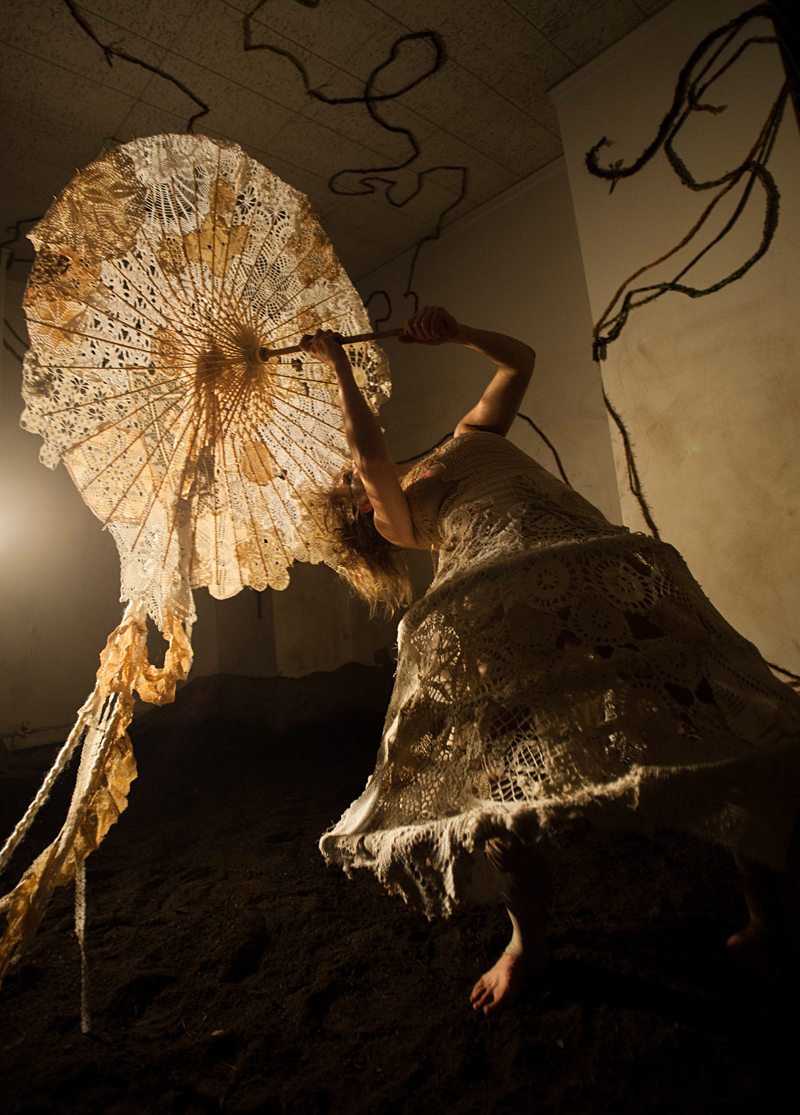Isadora Duncan used to talk about the “dancer of the future [with] the highest intelligence in the freest body,” but sometimes it’s their limitations that make performers fascinating. In Manifold Motion’s new performance installation, Under, the most interesting work comes from constraints. Freedom doesn’t really figure in the mix.
Under unfolds in three prepared rooms at INSCAPE (aka the old INS building): some fanciful (with chiming bells and flashing lights), some kind of icky (clay slurry dripping down the wall). They’re supposed to be interactive, like a children’s-museum exhibit, but adult viewers are understandably shy about touching what Manifold Motion describes as Under‘s inspiration—”lichens, fungi, moss, and mold.” Our guide is the “Moldy Minstrel” (Alexandra Baybutt), like some Art Nouveau faerie, whose light, sprightly movement contrasts with the dank surroundings.
The first room is lined with canvas and studded with fibrous growths like a giant macramé project; then everything is covered in clay dust. The performers, scattered throughout the space like rocks or lizards, are mostly still, except for Elizabeth Rose. She shifts and twitches in the corner, back to the floor as she runs her foot up and down the wall. But she can only climb so high; eventually we realize that her hands, hidden by elaborate sleeves, are somehow attached to the floor. What seemed like an eccentric movement choice now looks more like desperation—attempts at escape, continually thwarted.
In the second chamber, Mary Cutrera emerges from a giant brown-paper nest like a furiously writhing snake. She’s laced from neck to ankles in an extremely tight lycra sheath, like a full-body corset. This emphasizes the sequential movement of her spine, but keeps her from any but the smallest of steps. As with Rose, her costume pins her in place.
The audience gets a real jolt entering the last room—the scent of mold, sand, and compost on the floor is very powerful. Video images are projected on more macramé, depicting cells dividing and crystals growing, but accelerated or distorted kaleidoscopically. Unfortunately, it takes the quartet of dancers too long to achieve the same intensity as the smell. They fidget and shuffle around until Emily German enters in a hoop skirt, carrying a large parasol. She herds the other performers into place, and it’s only then that the movement achieves any urgency. Ironically, though less constricted than the prior performers, this crew is more sluggish and phlegmatic.
That awkward imbalance dogs the entire show. Each vignette is fairly short, but as a result, the movement ideas don’t seem developed. In general, Under needs more—more time to watch clay drip down the wall, more ripped-up brown paper in the snake nest, even more macramé and (God help anyone with allergies) more mold. In order to match the impact of performers like Cutrera and Rose, Under needs to be more over-the-top.








